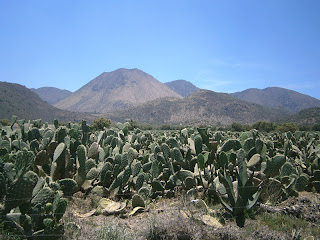The road from Oaxaca to Puebla was not particularly interesting: mostly cactus (which I was getting used to). But it was beautiful in its own way. By the way, a lot of this cactus is grown for food. The "leaves" are really tasty when cooked. Best to leave off the pointy things, however.
The town of Puebla itself is not particularly interesting. It is large and commercial, but for just this reason I thought I might be able to find the motorcycle parts that I needed to fix the cooling system. No such luck, but I did manage to get on line and order them shipped to my sister's house in LA so that I could do a more permanent fix there.
My first hotel is Puebla was one of the more bizarre places I have stayed. First, it looks like it was built out of rejects from Tiles 'R' Us. Every square inch of the place is tiled. Unfortunately, there are large opaque glass windows onto the hallway so you can hear every sound in the hall... or in the other rooms! One night in this place was enough. I moved to a much quieter hostel the next morning.
However, Puebla does have one of the nicest and liveliest zocalos (main plaza) that I have seen. Both nights in town I went to one of the many restaurants lining the square for a drink, a cigar, and dinner.
I also liked watching all the activities around the square. It's particularly popular with families.
From Puebla I headed for Pachuca. This was one of the few times that I took the Mexican toll road. In general, I avoid them because while they are faster and often better paved, they also avoid all the villages and so are boring! However, they also avoid a lot of the speed bumps, which is a good thing.

On the way I encountered the Division Bikers motorcycle club from Mexico City, who thought I was loco for doing this trip, although every one of them said they wanted to do the same thing.
My next stop was Pachuca. There was no particular reason for picking this town, just that it was on the way.
My hotel was the 100 year old Hotel de los Banos. While it would have been nice if it was named this for the thermal baths that it was famous for, this was not the case. It got its name because it was the first hotel in the area that had indoor plumbing! Oh well, they were nice enough to let me park El Pinguino in the lobby.
The center of the city, and what it is known for, is the clock tower in the central plaza. This was built in 1910 to commemorate the centennial of Mexico's independence.
The other thing that enjoyed walking around the city was the area of florists. Dozens of them. Beautiful, but not an ideal place for someone suffering from hay fever!





















































